Conflict and Negotiation Report: Management Strategies and Tools
VerifiedAdded on 2020/05/28
|9
|1763
|153
Report
AI Summary
This report provides an overview of conflict and negotiation, exploring various conflict management theories and their applications. It discusses the nature of conflict, its sources, and different perspectives on its management. The report highlights two key tools for effective negotiation: the Johari Window, which enhances self-awareness and interpersonal relationships, and the conflict questionnaire, which assesses individual conflict resolution styles. Furthermore, it examines different conflict resolution styles, including withdrawing, forceful, smoothing, confronting, and compromising approaches. The report also identifies areas for improvement, such as increasing the 'known' area in the Johari Window and suggests a six-month action plan involving the use of the conflict questionnaire to monitor progress in conflict resolution skills. The report emphasizes the importance of maturity and understanding in managing conflicts effectively, ultimately aiming to foster better relationships and collaborations.
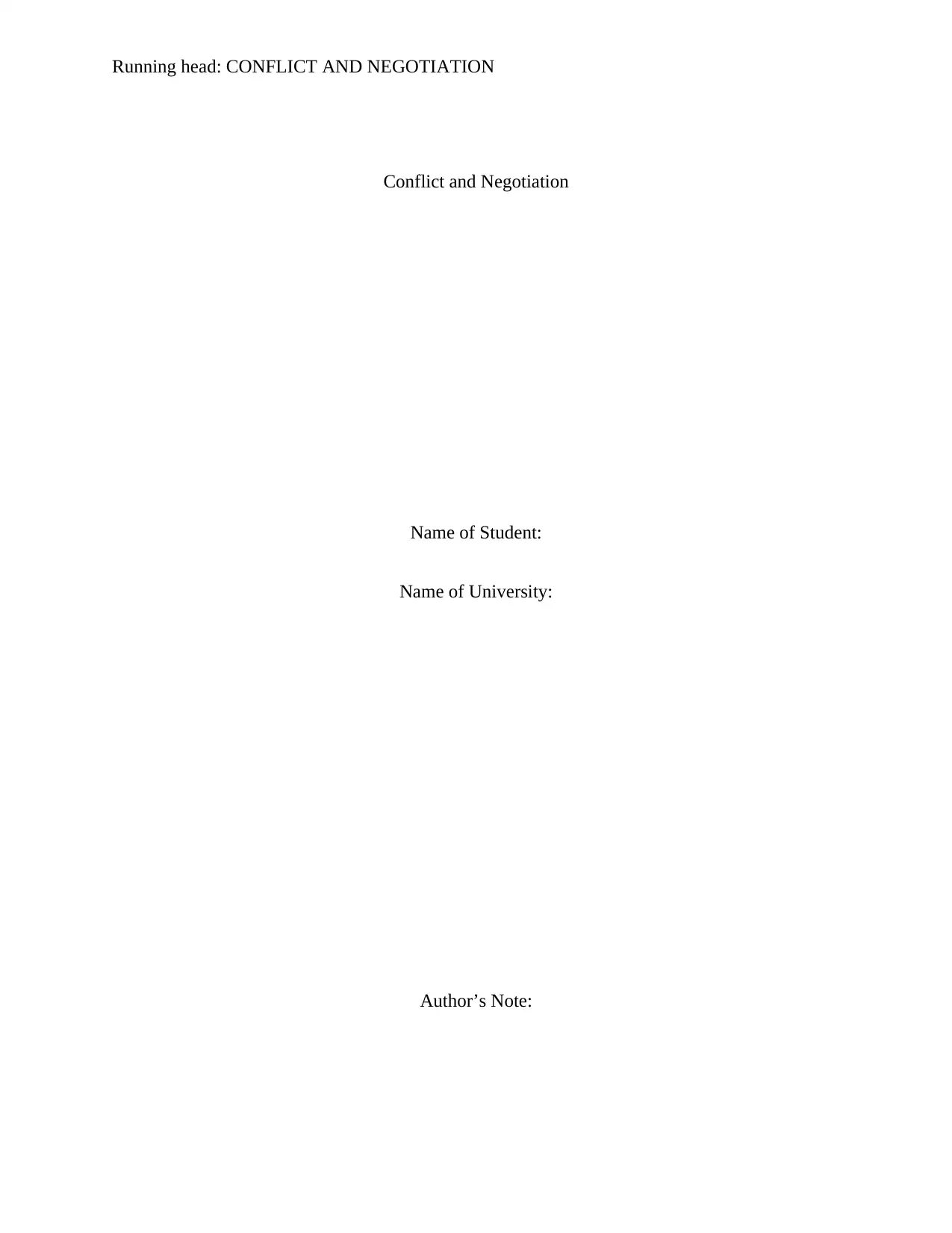
Running head: CONFLICT AND NEGOTIATION
Conflict and Negotiation
Name of Student:
Name of University:
Author’s Note:
Conflict and Negotiation
Name of Student:
Name of University:
Author’s Note:
Paraphrase This Document
Need a fresh take? Get an instant paraphrase of this document with our AI Paraphraser
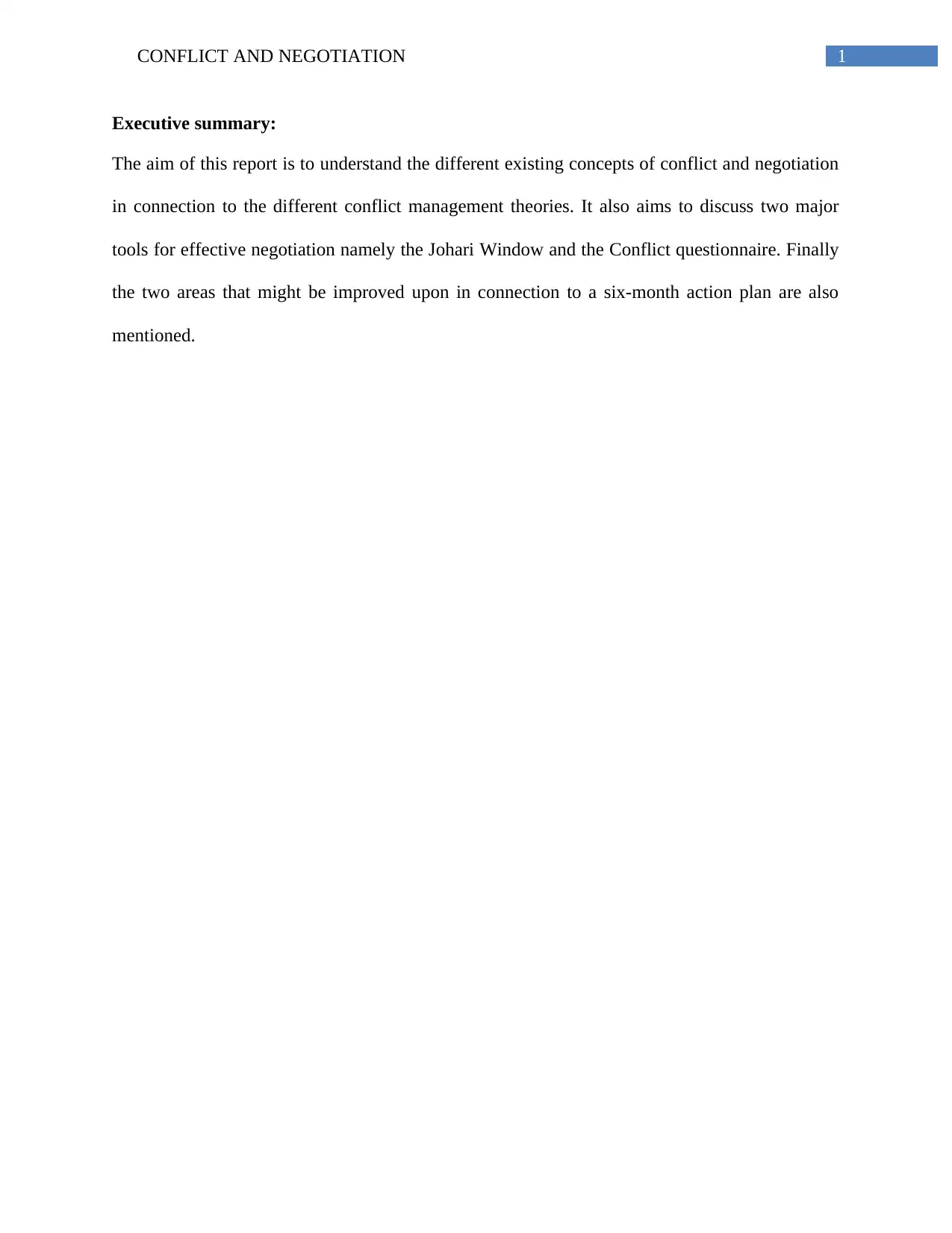
1CONFLICT AND NEGOTIATION
Executive summary:
The aim of this report is to understand the different existing concepts of conflict and negotiation
in connection to the different conflict management theories. It also aims to discuss two major
tools for effective negotiation namely the Johari Window and the Conflict questionnaire. Finally
the two areas that might be improved upon in connection to a six-month action plan are also
mentioned.
Executive summary:
The aim of this report is to understand the different existing concepts of conflict and negotiation
in connection to the different conflict management theories. It also aims to discuss two major
tools for effective negotiation namely the Johari Window and the Conflict questionnaire. Finally
the two areas that might be improved upon in connection to a six-month action plan are also
mentioned.
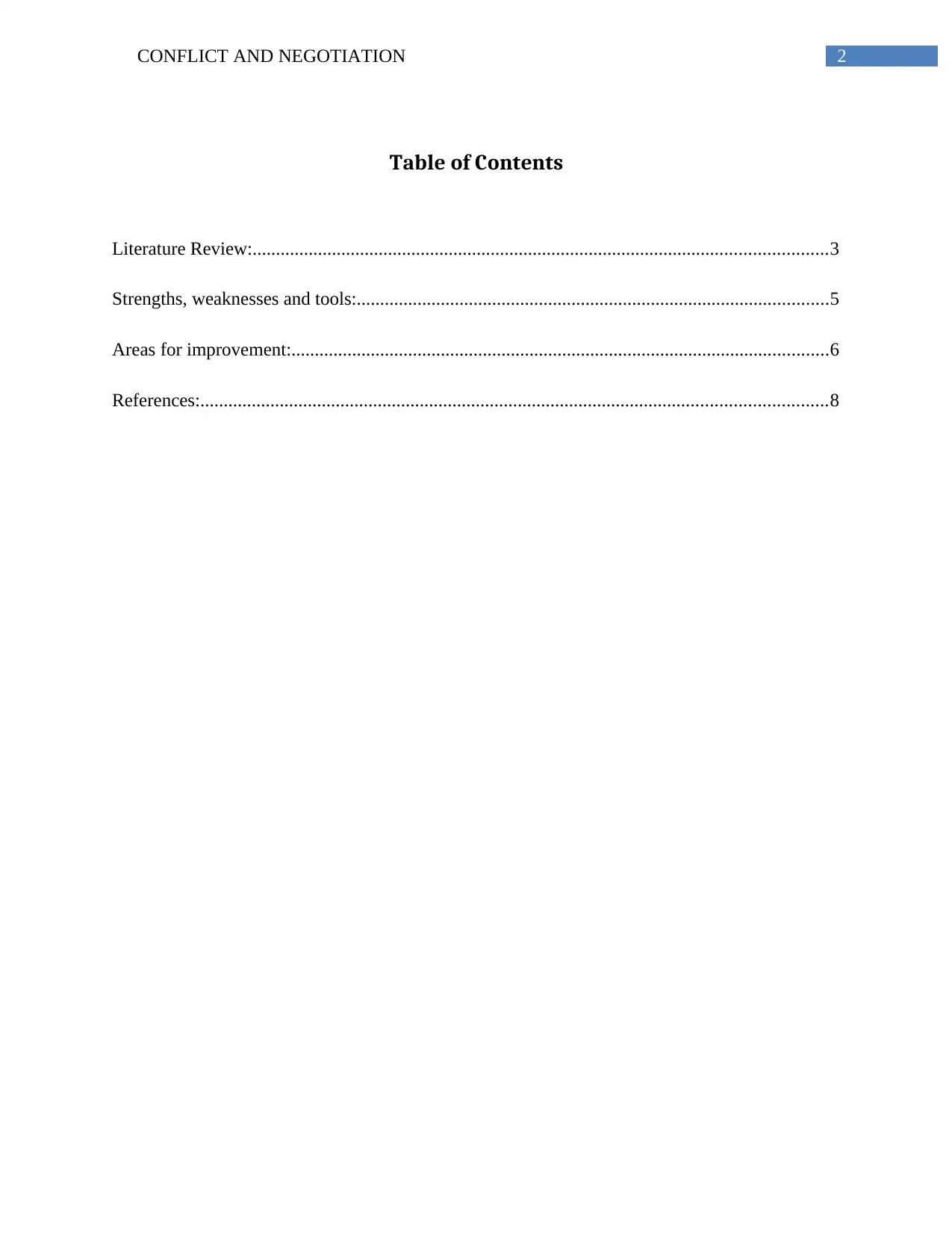
2CONFLICT AND NEGOTIATION
Table of Contents
Literature Review:...........................................................................................................................3
Strengths, weaknesses and tools:.....................................................................................................5
Areas for improvement:...................................................................................................................6
References:......................................................................................................................................8
Table of Contents
Literature Review:...........................................................................................................................3
Strengths, weaknesses and tools:.....................................................................................................5
Areas for improvement:...................................................................................................................6
References:......................................................................................................................................8
⊘ This is a preview!⊘
Do you want full access?
Subscribe today to unlock all pages.

Trusted by 1+ million students worldwide
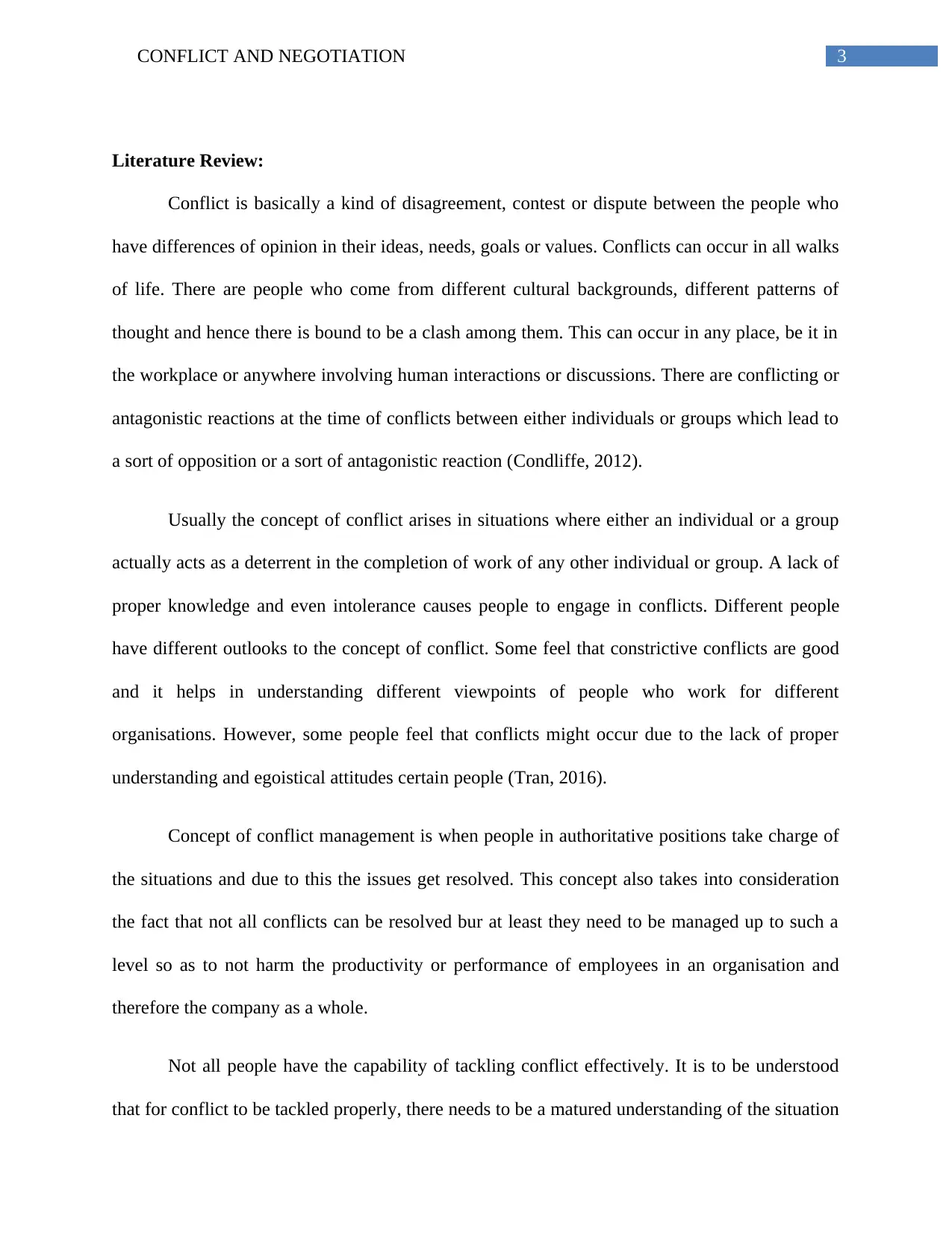
3CONFLICT AND NEGOTIATION
Literature Review:
Conflict is basically a kind of disagreement, contest or dispute between the people who
have differences of opinion in their ideas, needs, goals or values. Conflicts can occur in all walks
of life. There are people who come from different cultural backgrounds, different patterns of
thought and hence there is bound to be a clash among them. This can occur in any place, be it in
the workplace or anywhere involving human interactions or discussions. There are conflicting or
antagonistic reactions at the time of conflicts between either individuals or groups which lead to
a sort of opposition or a sort of antagonistic reaction (Condliffe, 2012).
Usually the concept of conflict arises in situations where either an individual or a group
actually acts as a deterrent in the completion of work of any other individual or group. A lack of
proper knowledge and even intolerance causes people to engage in conflicts. Different people
have different outlooks to the concept of conflict. Some feel that constrictive conflicts are good
and it helps in understanding different viewpoints of people who work for different
organisations. However, some people feel that conflicts might occur due to the lack of proper
understanding and egoistical attitudes certain people (Tran, 2016).
Concept of conflict management is when people in authoritative positions take charge of
the situations and due to this the issues get resolved. This concept also takes into consideration
the fact that not all conflicts can be resolved bur at least they need to be managed up to such a
level so as to not harm the productivity or performance of employees in an organisation and
therefore the company as a whole.
Not all people have the capability of tackling conflict effectively. It is to be understood
that for conflict to be tackled properly, there needs to be a matured understanding of the situation
Literature Review:
Conflict is basically a kind of disagreement, contest or dispute between the people who
have differences of opinion in their ideas, needs, goals or values. Conflicts can occur in all walks
of life. There are people who come from different cultural backgrounds, different patterns of
thought and hence there is bound to be a clash among them. This can occur in any place, be it in
the workplace or anywhere involving human interactions or discussions. There are conflicting or
antagonistic reactions at the time of conflicts between either individuals or groups which lead to
a sort of opposition or a sort of antagonistic reaction (Condliffe, 2012).
Usually the concept of conflict arises in situations where either an individual or a group
actually acts as a deterrent in the completion of work of any other individual or group. A lack of
proper knowledge and even intolerance causes people to engage in conflicts. Different people
have different outlooks to the concept of conflict. Some feel that constrictive conflicts are good
and it helps in understanding different viewpoints of people who work for different
organisations. However, some people feel that conflicts might occur due to the lack of proper
understanding and egoistical attitudes certain people (Tran, 2016).
Concept of conflict management is when people in authoritative positions take charge of
the situations and due to this the issues get resolved. This concept also takes into consideration
the fact that not all conflicts can be resolved bur at least they need to be managed up to such a
level so as to not harm the productivity or performance of employees in an organisation and
therefore the company as a whole.
Not all people have the capability of tackling conflict effectively. It is to be understood
that for conflict to be tackled properly, there needs to be a matured understanding of the situation
Paraphrase This Document
Need a fresh take? Get an instant paraphrase of this document with our AI Paraphraser
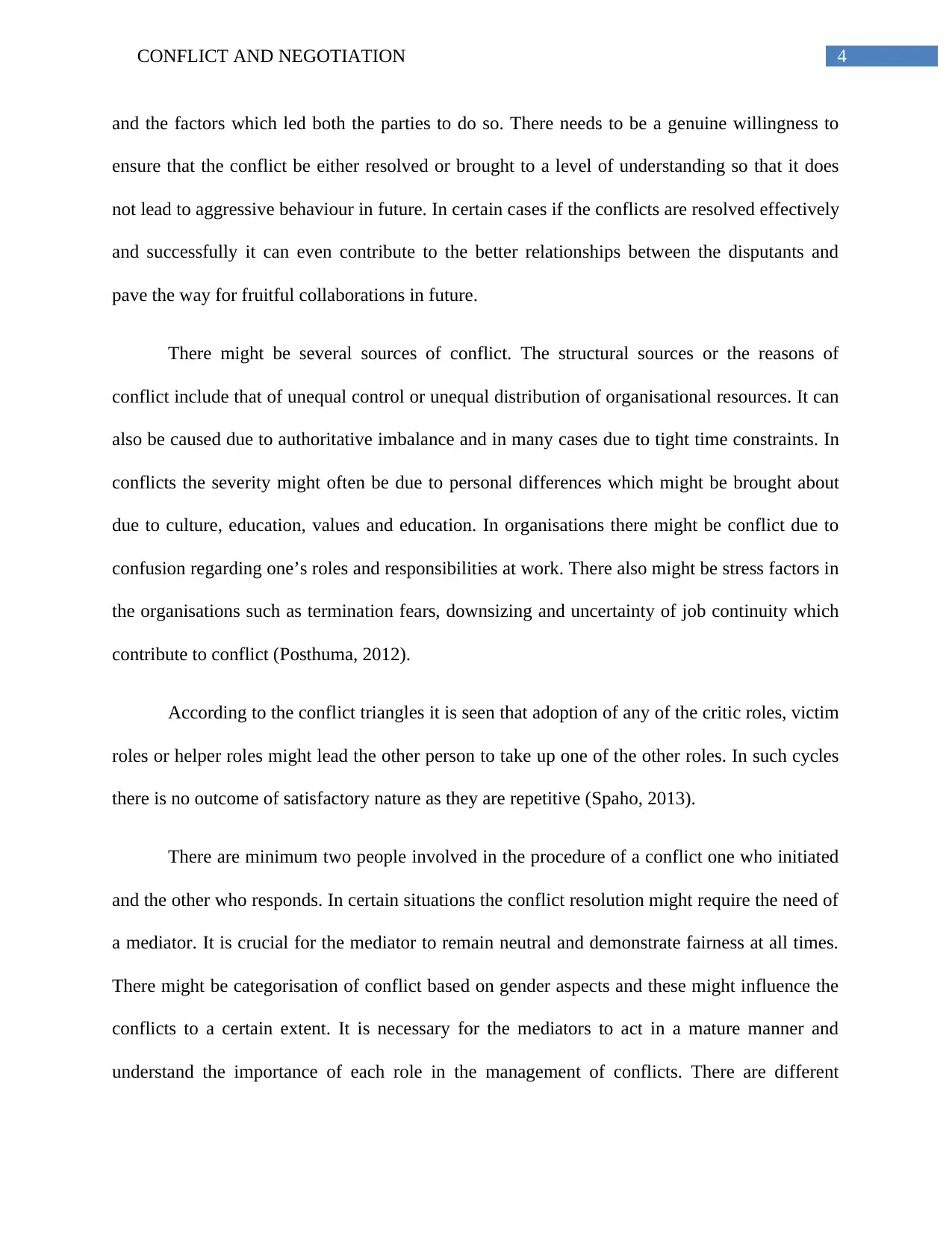
4CONFLICT AND NEGOTIATION
and the factors which led both the parties to do so. There needs to be a genuine willingness to
ensure that the conflict be either resolved or brought to a level of understanding so that it does
not lead to aggressive behaviour in future. In certain cases if the conflicts are resolved effectively
and successfully it can even contribute to the better relationships between the disputants and
pave the way for fruitful collaborations in future.
There might be several sources of conflict. The structural sources or the reasons of
conflict include that of unequal control or unequal distribution of organisational resources. It can
also be caused due to authoritative imbalance and in many cases due to tight time constraints. In
conflicts the severity might often be due to personal differences which might be brought about
due to culture, education, values and education. In organisations there might be conflict due to
confusion regarding one’s roles and responsibilities at work. There also might be stress factors in
the organisations such as termination fears, downsizing and uncertainty of job continuity which
contribute to conflict (Posthuma, 2012).
According to the conflict triangles it is seen that adoption of any of the critic roles, victim
roles or helper roles might lead the other person to take up one of the other roles. In such cycles
there is no outcome of satisfactory nature as they are repetitive (Spaho, 2013).
There are minimum two people involved in the procedure of a conflict one who initiated
and the other who responds. In certain situations the conflict resolution might require the need of
a mediator. It is crucial for the mediator to remain neutral and demonstrate fairness at all times.
There might be categorisation of conflict based on gender aspects and these might influence the
conflicts to a certain extent. It is necessary for the mediators to act in a mature manner and
understand the importance of each role in the management of conflicts. There are different
and the factors which led both the parties to do so. There needs to be a genuine willingness to
ensure that the conflict be either resolved or brought to a level of understanding so that it does
not lead to aggressive behaviour in future. In certain cases if the conflicts are resolved effectively
and successfully it can even contribute to the better relationships between the disputants and
pave the way for fruitful collaborations in future.
There might be several sources of conflict. The structural sources or the reasons of
conflict include that of unequal control or unequal distribution of organisational resources. It can
also be caused due to authoritative imbalance and in many cases due to tight time constraints. In
conflicts the severity might often be due to personal differences which might be brought about
due to culture, education, values and education. In organisations there might be conflict due to
confusion regarding one’s roles and responsibilities at work. There also might be stress factors in
the organisations such as termination fears, downsizing and uncertainty of job continuity which
contribute to conflict (Posthuma, 2012).
According to the conflict triangles it is seen that adoption of any of the critic roles, victim
roles or helper roles might lead the other person to take up one of the other roles. In such cycles
there is no outcome of satisfactory nature as they are repetitive (Spaho, 2013).
There are minimum two people involved in the procedure of a conflict one who initiated
and the other who responds. In certain situations the conflict resolution might require the need of
a mediator. It is crucial for the mediator to remain neutral and demonstrate fairness at all times.
There might be categorisation of conflict based on gender aspects and these might influence the
conflicts to a certain extent. It is necessary for the mediators to act in a mature manner and
understand the importance of each role in the management of conflicts. There are different
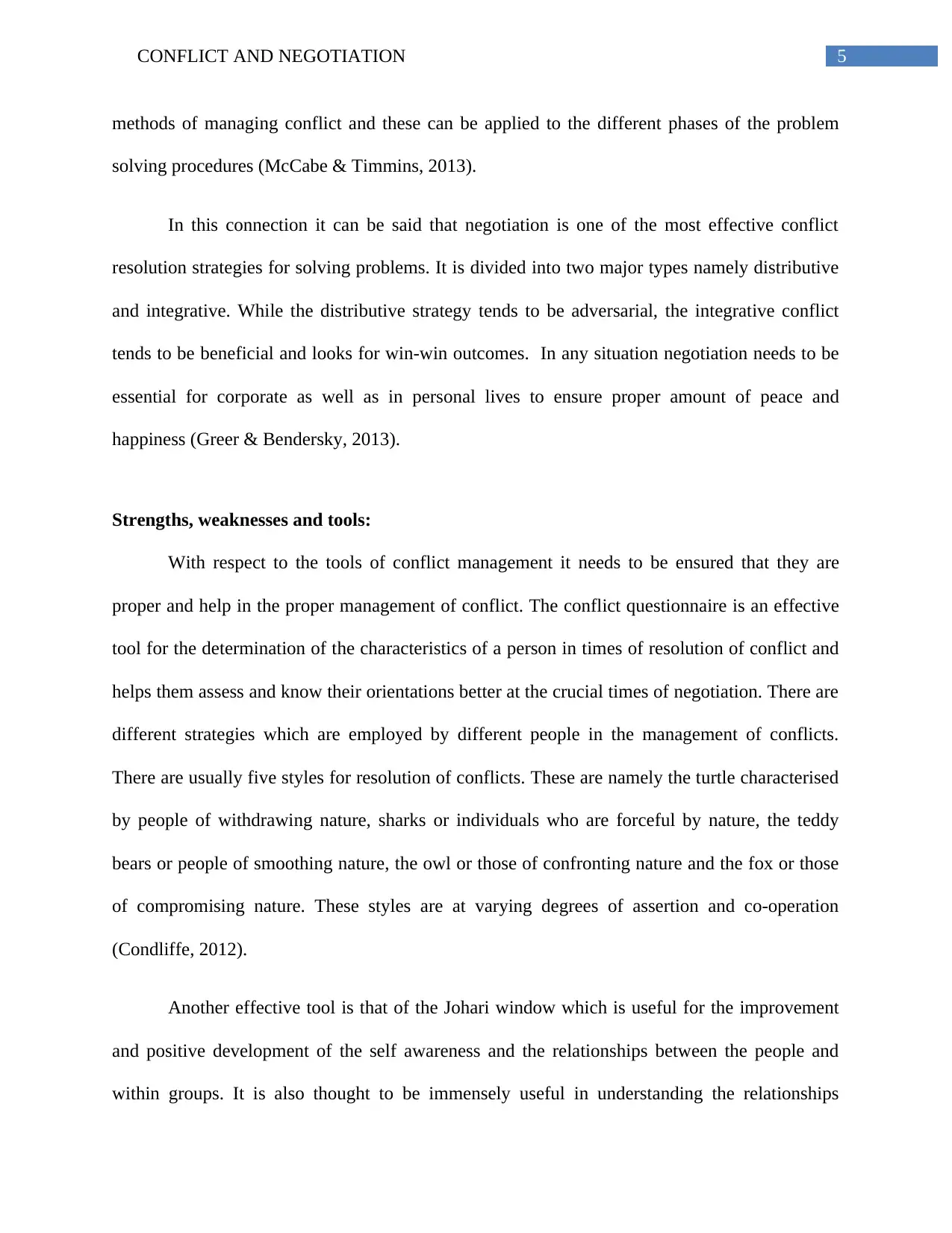
5CONFLICT AND NEGOTIATION
methods of managing conflict and these can be applied to the different phases of the problem
solving procedures (McCabe & Timmins, 2013).
In this connection it can be said that negotiation is one of the most effective conflict
resolution strategies for solving problems. It is divided into two major types namely distributive
and integrative. While the distributive strategy tends to be adversarial, the integrative conflict
tends to be beneficial and looks for win-win outcomes. In any situation negotiation needs to be
essential for corporate as well as in personal lives to ensure proper amount of peace and
happiness (Greer & Bendersky, 2013).
Strengths, weaknesses and tools:
With respect to the tools of conflict management it needs to be ensured that they are
proper and help in the proper management of conflict. The conflict questionnaire is an effective
tool for the determination of the characteristics of a person in times of resolution of conflict and
helps them assess and know their orientations better at the crucial times of negotiation. There are
different strategies which are employed by different people in the management of conflicts.
There are usually five styles for resolution of conflicts. These are namely the turtle characterised
by people of withdrawing nature, sharks or individuals who are forceful by nature, the teddy
bears or people of smoothing nature, the owl or those of confronting nature and the fox or those
of compromising nature. These styles are at varying degrees of assertion and co-operation
(Condliffe, 2012).
Another effective tool is that of the Johari window which is useful for the improvement
and positive development of the self awareness and the relationships between the people and
within groups. It is also thought to be immensely useful in understanding the relationships
methods of managing conflict and these can be applied to the different phases of the problem
solving procedures (McCabe & Timmins, 2013).
In this connection it can be said that negotiation is one of the most effective conflict
resolution strategies for solving problems. It is divided into two major types namely distributive
and integrative. While the distributive strategy tends to be adversarial, the integrative conflict
tends to be beneficial and looks for win-win outcomes. In any situation negotiation needs to be
essential for corporate as well as in personal lives to ensure proper amount of peace and
happiness (Greer & Bendersky, 2013).
Strengths, weaknesses and tools:
With respect to the tools of conflict management it needs to be ensured that they are
proper and help in the proper management of conflict. The conflict questionnaire is an effective
tool for the determination of the characteristics of a person in times of resolution of conflict and
helps them assess and know their orientations better at the crucial times of negotiation. There are
different strategies which are employed by different people in the management of conflicts.
There are usually five styles for resolution of conflicts. These are namely the turtle characterised
by people of withdrawing nature, sharks or individuals who are forceful by nature, the teddy
bears or people of smoothing nature, the owl or those of confronting nature and the fox or those
of compromising nature. These styles are at varying degrees of assertion and co-operation
(Condliffe, 2012).
Another effective tool is that of the Johari window which is useful for the improvement
and positive development of the self awareness and the relationships between the people and
within groups. It is also thought to be immensely useful in understanding the relationships
⊘ This is a preview!⊘
Do you want full access?
Subscribe today to unlock all pages.

Trusted by 1+ million students worldwide
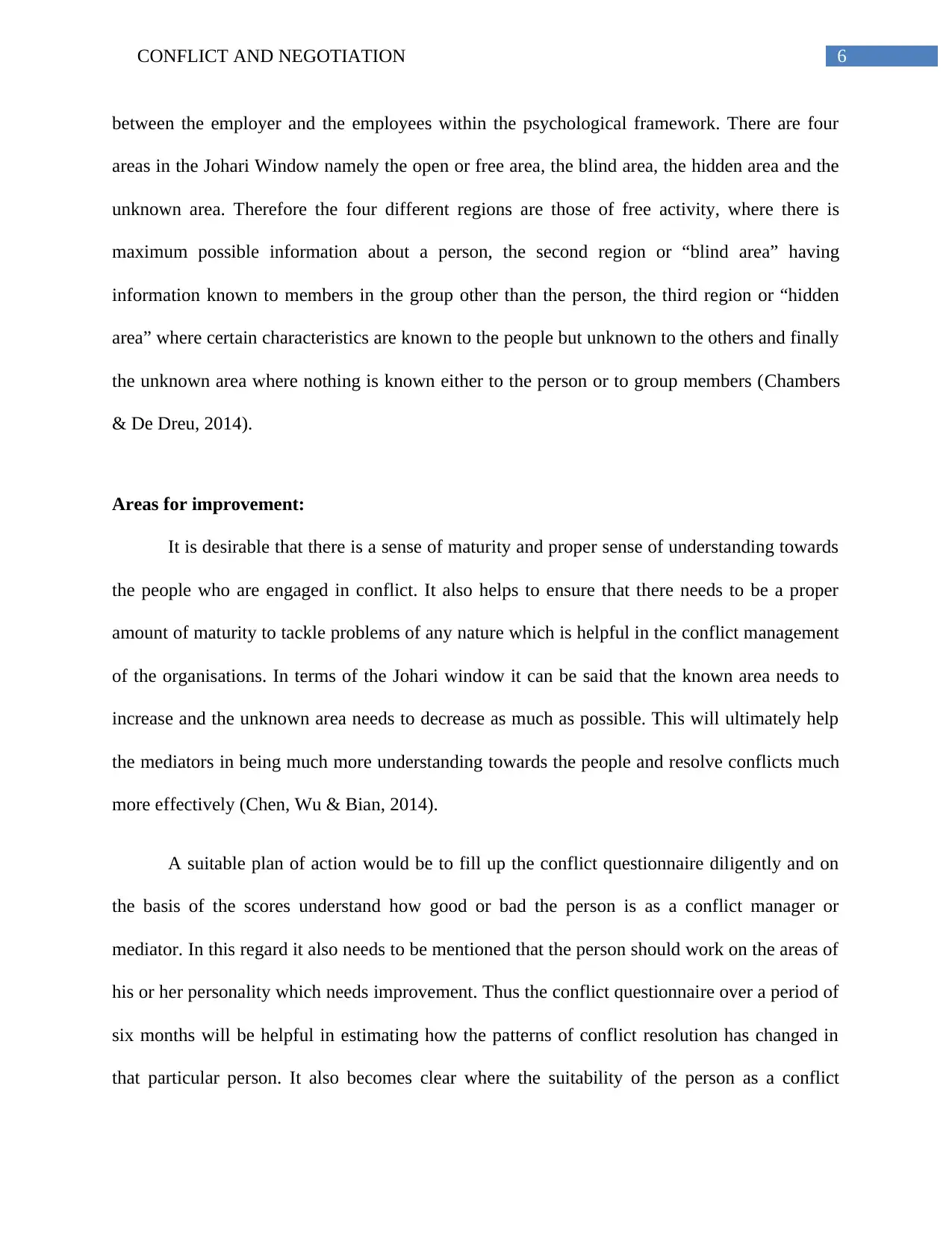
6CONFLICT AND NEGOTIATION
between the employer and the employees within the psychological framework. There are four
areas in the Johari Window namely the open or free area, the blind area, the hidden area and the
unknown area. Therefore the four different regions are those of free activity, where there is
maximum possible information about a person, the second region or “blind area” having
information known to members in the group other than the person, the third region or “hidden
area” where certain characteristics are known to the people but unknown to the others and finally
the unknown area where nothing is known either to the person or to group members (Chambers
& De Dreu, 2014).
Areas for improvement:
It is desirable that there is a sense of maturity and proper sense of understanding towards
the people who are engaged in conflict. It also helps to ensure that there needs to be a proper
amount of maturity to tackle problems of any nature which is helpful in the conflict management
of the organisations. In terms of the Johari window it can be said that the known area needs to
increase and the unknown area needs to decrease as much as possible. This will ultimately help
the mediators in being much more understanding towards the people and resolve conflicts much
more effectively (Chen, Wu & Bian, 2014).
A suitable plan of action would be to fill up the conflict questionnaire diligently and on
the basis of the scores understand how good or bad the person is as a conflict manager or
mediator. In this regard it also needs to be mentioned that the person should work on the areas of
his or her personality which needs improvement. Thus the conflict questionnaire over a period of
six months will be helpful in estimating how the patterns of conflict resolution has changed in
that particular person. It also becomes clear where the suitability of the person as a conflict
between the employer and the employees within the psychological framework. There are four
areas in the Johari Window namely the open or free area, the blind area, the hidden area and the
unknown area. Therefore the four different regions are those of free activity, where there is
maximum possible information about a person, the second region or “blind area” having
information known to members in the group other than the person, the third region or “hidden
area” where certain characteristics are known to the people but unknown to the others and finally
the unknown area where nothing is known either to the person or to group members (Chambers
& De Dreu, 2014).
Areas for improvement:
It is desirable that there is a sense of maturity and proper sense of understanding towards
the people who are engaged in conflict. It also helps to ensure that there needs to be a proper
amount of maturity to tackle problems of any nature which is helpful in the conflict management
of the organisations. In terms of the Johari window it can be said that the known area needs to
increase and the unknown area needs to decrease as much as possible. This will ultimately help
the mediators in being much more understanding towards the people and resolve conflicts much
more effectively (Chen, Wu & Bian, 2014).
A suitable plan of action would be to fill up the conflict questionnaire diligently and on
the basis of the scores understand how good or bad the person is as a conflict manager or
mediator. In this regard it also needs to be mentioned that the person should work on the areas of
his or her personality which needs improvement. Thus the conflict questionnaire over a period of
six months will be helpful in estimating how the patterns of conflict resolution has changed in
that particular person. It also becomes clear where the suitability of the person as a conflict
Paraphrase This Document
Need a fresh take? Get an instant paraphrase of this document with our AI Paraphraser
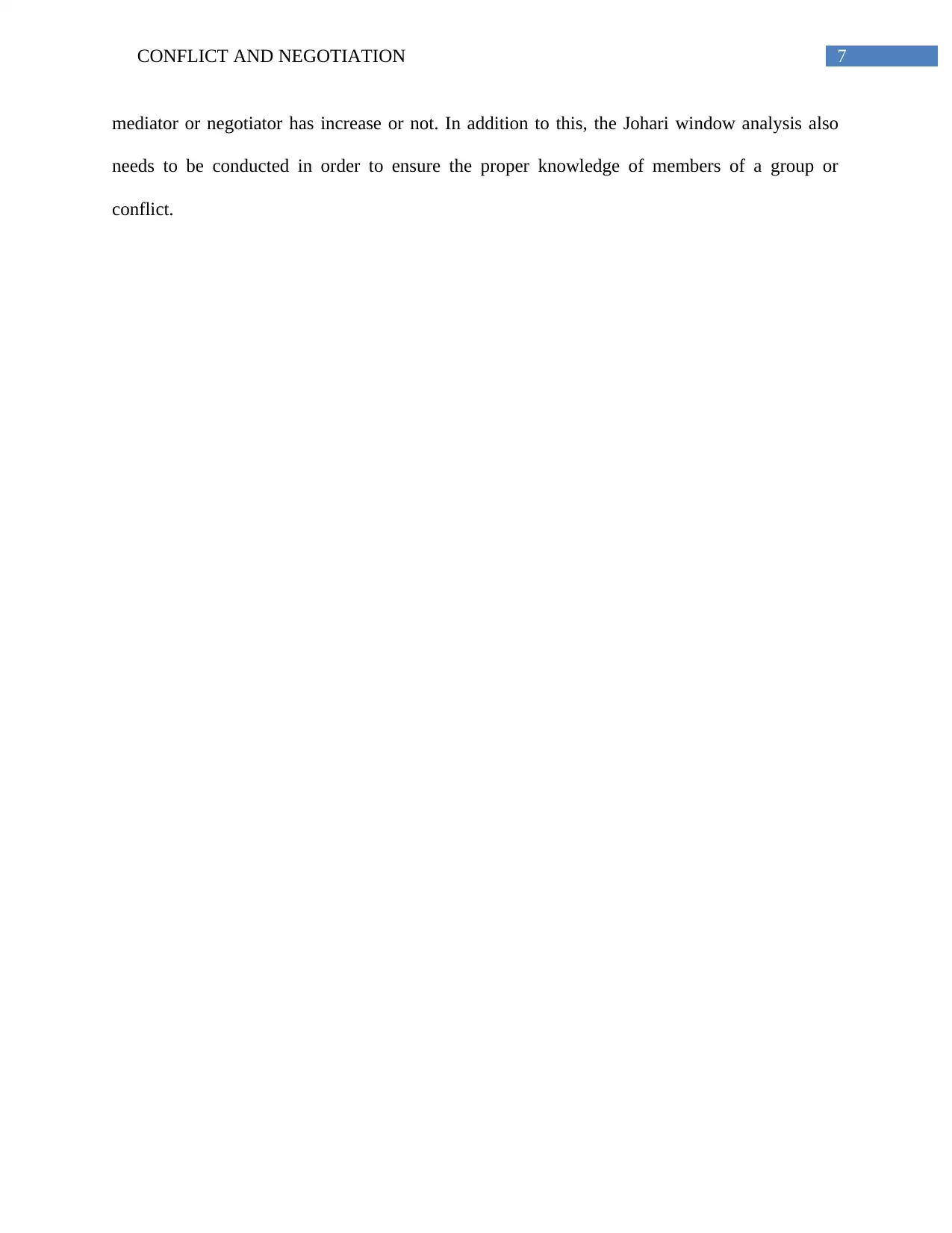
7CONFLICT AND NEGOTIATION
mediator or negotiator has increase or not. In addition to this, the Johari window analysis also
needs to be conducted in order to ensure the proper knowledge of members of a group or
conflict.
mediator or negotiator has increase or not. In addition to this, the Johari window analysis also
needs to be conducted in order to ensure the proper knowledge of members of a group or
conflict.
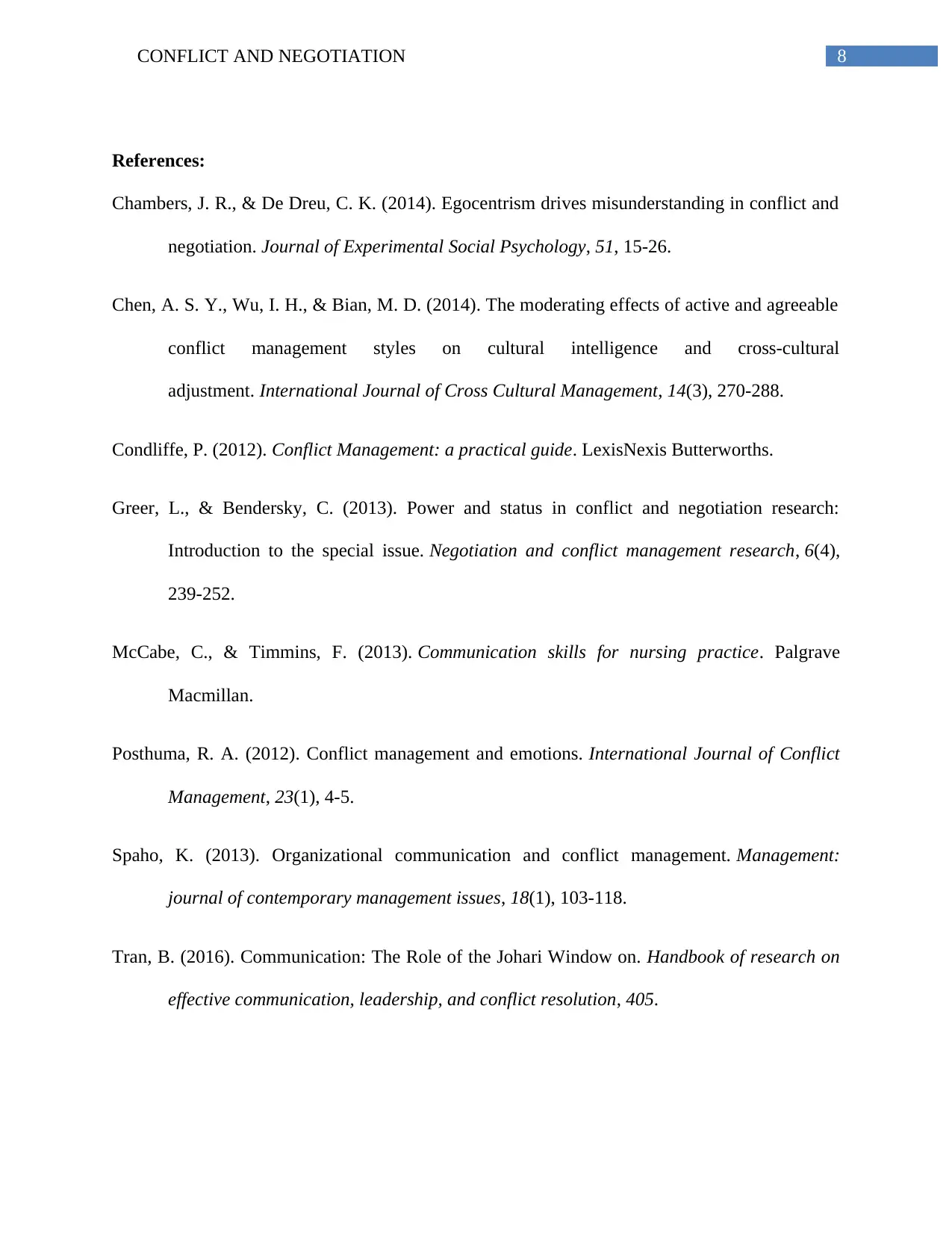
8CONFLICT AND NEGOTIATION
References:
Chambers, J. R., & De Dreu, C. K. (2014). Egocentrism drives misunderstanding in conflict and
negotiation. Journal of Experimental Social Psychology, 51, 15-26.
Chen, A. S. Y., Wu, I. H., & Bian, M. D. (2014). The moderating effects of active and agreeable
conflict management styles on cultural intelligence and cross-cultural
adjustment. International Journal of Cross Cultural Management, 14(3), 270-288.
Condliffe, P. (2012). Conflict Management: a practical guide. LexisNexis Butterworths.
Greer, L., & Bendersky, C. (2013). Power and status in conflict and negotiation research:
Introduction to the special issue. Negotiation and conflict management research, 6(4),
239-252.
McCabe, C., & Timmins, F. (2013). Communication skills for nursing practice. Palgrave
Macmillan.
Posthuma, R. A. (2012). Conflict management and emotions. International Journal of Conflict
Management, 23(1), 4-5.
Spaho, K. (2013). Organizational communication and conflict management. Management:
journal of contemporary management issues, 18(1), 103-118.
Tran, B. (2016). Communication: The Role of the Johari Window on. Handbook of research on
effective communication, leadership, and conflict resolution, 405.
References:
Chambers, J. R., & De Dreu, C. K. (2014). Egocentrism drives misunderstanding in conflict and
negotiation. Journal of Experimental Social Psychology, 51, 15-26.
Chen, A. S. Y., Wu, I. H., & Bian, M. D. (2014). The moderating effects of active and agreeable
conflict management styles on cultural intelligence and cross-cultural
adjustment. International Journal of Cross Cultural Management, 14(3), 270-288.
Condliffe, P. (2012). Conflict Management: a practical guide. LexisNexis Butterworths.
Greer, L., & Bendersky, C. (2013). Power and status in conflict and negotiation research:
Introduction to the special issue. Negotiation and conflict management research, 6(4),
239-252.
McCabe, C., & Timmins, F. (2013). Communication skills for nursing practice. Palgrave
Macmillan.
Posthuma, R. A. (2012). Conflict management and emotions. International Journal of Conflict
Management, 23(1), 4-5.
Spaho, K. (2013). Organizational communication and conflict management. Management:
journal of contemporary management issues, 18(1), 103-118.
Tran, B. (2016). Communication: The Role of the Johari Window on. Handbook of research on
effective communication, leadership, and conflict resolution, 405.
⊘ This is a preview!⊘
Do you want full access?
Subscribe today to unlock all pages.

Trusted by 1+ million students worldwide
1 out of 9
Related Documents
Your All-in-One AI-Powered Toolkit for Academic Success.
+13062052269
info@desklib.com
Available 24*7 on WhatsApp / Email
![[object Object]](/_next/static/media/star-bottom.7253800d.svg)
Unlock your academic potential
Copyright © 2020–2025 A2Z Services. All Rights Reserved. Developed and managed by ZUCOL.





